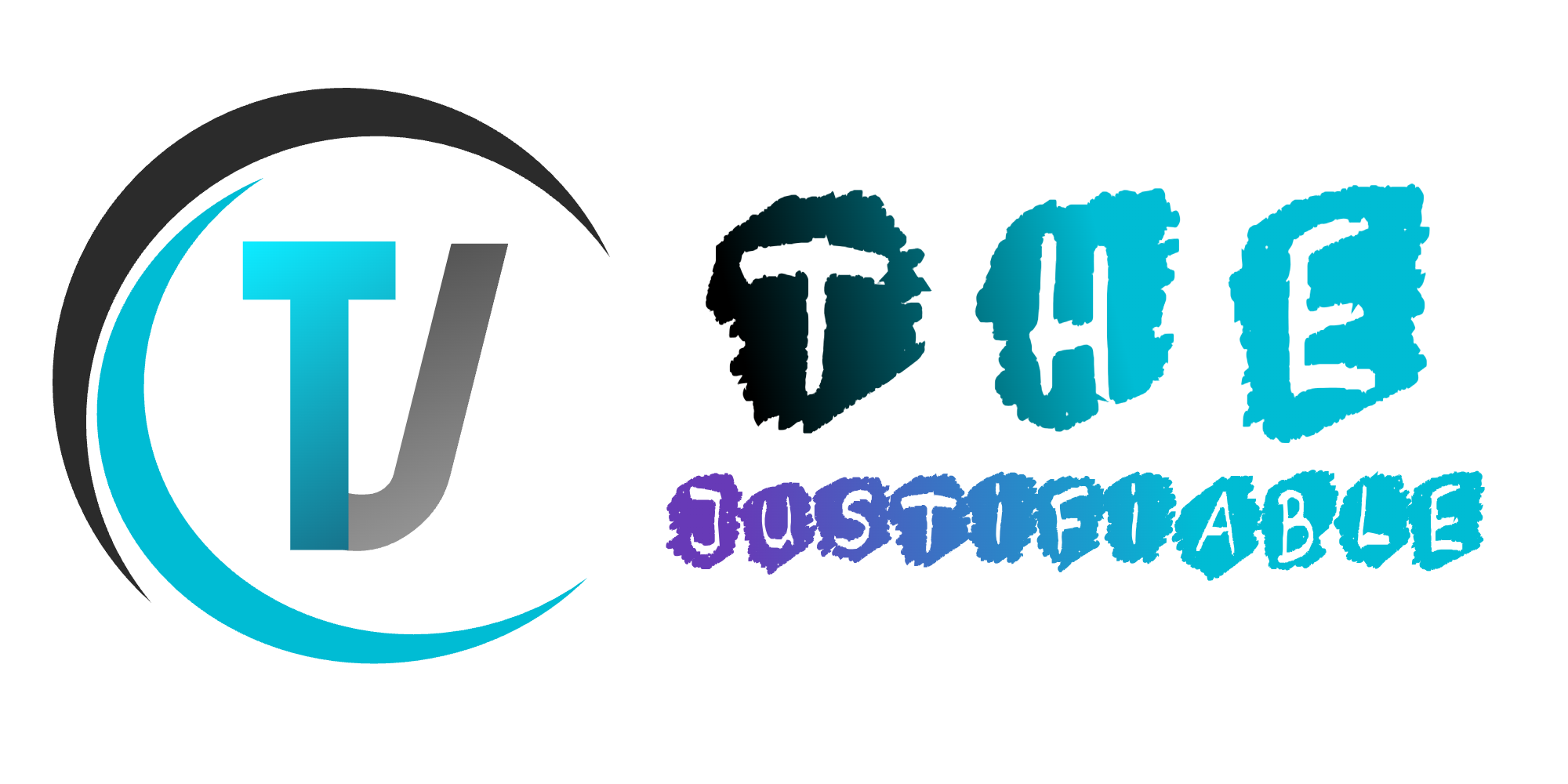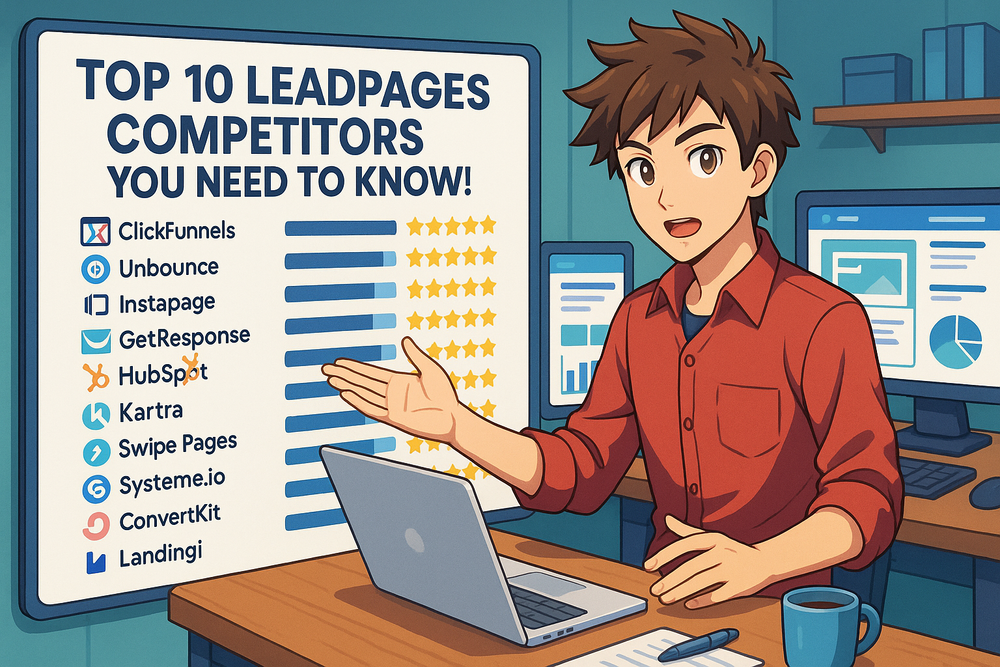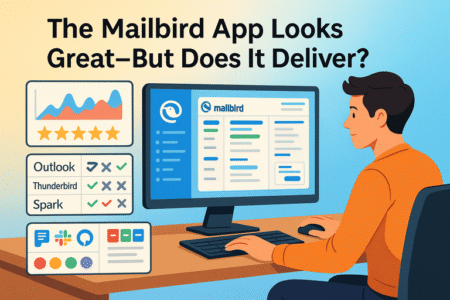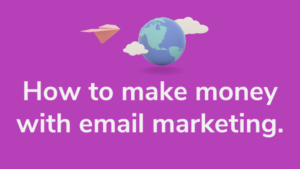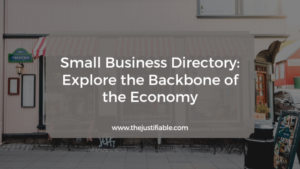Table of Contents
Are you feeling limited by Leadpages and wondering if there are better options out there? Curious which leadpages competitors could offer more flexibility, better pricing, or features that better fit your business goals? If you’re searching for landing page solutions that can drive higher conversions and offer a smoother experience, you’re in the right place.
In this guide, we’ll dive into the top 10 leadpages competitors you need to know. I’ll break down what makes each one stand out, how they compare to Leadpages, and which could be the perfect match for your marketing needs.
Alternative 1: Unbounce – The King of A/B Testing and Optimization

If you’re constantly tweaking landing pages to improve performance, Unbounce might be the Leadpages alternative you’ve been missing. Known for its unmatched A/B testing capabilities and optimization tools, Unbounce is ideal for marketers who want fine-grained control over conversion rates.
Why Unbounce Outperforms Leadpages in Split Testing
Let me break it down for you—Unbounce was practically built with testing in its DNA. Where Leadpages offers basic A/B testing, Unbounce goes deep. You get control over traffic distribution, multivariate testing options, and real-time analytics that help you test every part of your landing page—from headlines to call-to-actions.
Unlike Leadpages, which offers limited insights and test segmentation, Unbounce allows you to:
- Run unlimited tests simultaneously across multiple variants.
- Adjust the percentage of traffic each version receives (rather than 50/50 defaults).
- Get immediate feedback with detailed reports, showing exactly where users drop off or convert.
For marketers aiming to squeeze out every bit of performance from their pages, this alone can be a game-changer. I’ve seen teams switch to Unbounce and instantly gain back hours lost to Leadpages’ more restricted test tools.
Key Features That Help Maximize Conversions
Where Unbounce really shines is in its optimization-driven features that are tailor-made for marketers who care about data, speed, and results. Here’s what stands out:
- Smart Traffic: Unbounce’s AI automatically directs visitors to the landing page variant most likely to convert based on their behavior, device, location, and more. This alone can improve conversions by up to 30%, according to Unbounce’s own data.
- Dynamic Text Replacement (DTR): This feature updates your page content based on keywords from a user’s search query, making your offer feel more relevant instantly.
- Custom Scripts and Integrations: Whether you want to add custom analytics tools, third-party widgets, or retargeting pixels, Unbounce’s flexibility allows for it without heavy dev work.
For users frustrated by Leadpages’ rigidity, these features offer a breath of fresh air and measurable improvements in campaign ROI.
👉 Want to boost conversions with smarter testing? Try Unbounce now
Pricing Breakdown and Value for Marketers
Unbounce’s pricing structure is more performance-oriented, which can be a plus or a minus depending on your needs.
- Launch Plan: Starts at $99/month with up to 500 conversions and 20,000 visitors per month.
- Optimize Plan: At $145/month, you unlock Smart Traffic, unlimited A/B tests, and higher limits.
- Accelerate Plan: Priced at $240/month, this is ideal for agencies or power users with advanced needs.
Compared to Leadpages’ lower price point, Unbounce is a bigger investment—but one that pays off when you’re actively optimizing campaigns and scaling conversion rates. If you’re data-driven and focused on results, Unbounce delivers tools that Leadpages competitors often lack.
Alternative 2: Instapage – Personalized Landing Experiences at Scale

If you’re running ads at scale or working within a large team, Instapage offers advanced personalization and collaboration tools that go well beyond what Leadpages can deliver. It’s purpose-built for teams that treat landing pages as serious revenue engines.
How Instapage’s Collaboration Tools Beat Leadpages
One of the biggest pain points with Leadpages is how limiting it can be for teams. If you’ve ever found yourself buried in email threads or Slack messages while reviewing a landing page draft, Instapage solves that. It has built-in collaboration tools that feel more like Google Docs than traditional landing page software.
Here’s what makes Instapage stand out:
- Real-Time Editing: Multiple users can work on the same page at once, without overwriting changes.
- Commenting and Feedback: Leave comments directly on design elements—just like you would in a Google Doc—making it easy for designers, copywriters, and marketers to stay aligned.
- Approval Workflows: Built-in workflows allow you to set user roles and get stakeholder sign-off without jumping into external tools.
For agencies or in-house teams juggling multiple campaigns, these features eliminate the bottlenecks that often slow down landing page production on Leadpages.
Unique Personalization Features You’ll Love
Instapage isn’t just about collaboration—it’s about personalization at scale. Their standout feature here is Ad-to-Page Personalization, which allows you to dynamically match landing page content with specific ad creatives or audience segments.
You can personalize landing pages based on:
- Geographic location
- Device type
- Campaign parameters
- Behavioral targeting from ad networks like Google Ads or Facebook
And it doesn’t stop there. With Global Blocks, you can manage and update repeated sections (like headers or disclaimers) across multiple pages in one go. This is something Leadpages simply doesn’t offer.
I’ve seen brands double down on this kind of personalization and see a lift in conversion rates without increasing ad spend—a smart move if you’re scaling paid campaigns.
🎯 Ready to personalize your landing pages at scale? Explore Instapage
Cost vs. Benefits for Growing Businesses
Instapage is definitely a premium tool, and that’s reflected in its pricing.
- Building Plan: Starts at $299/month (or custom pricing for Enterprise users).
- Enterprise Plans: Include everything from heatmaps and audit logs to AMP pages and advanced integrations.
Is it expensive? Yes. But here’s the deal: if you’re a solo entrepreneur or a small team running basic landing pages, this might feel like overkill. But for businesses managing large-scale campaigns, the time saved and performance gained make it worth every penny.
You’re not just paying for software—you’re investing in a system that helps your marketing team work faster, smarter, and more efficiently. Compared to other Leadpages competitors, Instapage may be the best fit for high-growth or performance-driven teams.
Alternative 3: ClickFunnels – Full Sales Funnel Solution

ClickFunnels steps in as one of the most talked-about Leadpages competitors, especially if you’re focused on more than just building landing pages. It’s designed to help entrepreneurs, marketers, and small businesses create complete sales funnels that guide visitors from the first click to the final purchase.
Why ClickFunnels Is Ideal for Building More Than Just Landing Pages
If you’ve ever felt boxed in by Leadpages’ single-page approach, ClickFunnels offers a much wider toolkit. Instead of focusing only on the landing page experience, it allows you to map out and build full funnels—opt-in pages, sales pages, checkout flows, upsells, and even membership sites.
That’s where it truly shines. You’re not just making a page; you’re creating a guided journey. Every element is built to move a lead toward action, whether that’s booking a call, making a purchase, or signing up for a webinar.
ClickFunnels also comes with a visual funnel builder that lets you see how all the steps connect. That kind of birds-eye view is missing in Leadpages and gives you a much clearer strategy when building campaigns.
So if your goal is to take someone from unaware to customer in a seamless experience, ClickFunnels may give you the all-in-one control Leadpages lacks.
Funnel Templates, Automation, and Upselling Power
Where ClickFunnels really stands out is in its ecosystem. You’re not starting from scratch. There’s a massive library of pre-built funnel templates for everything from product launches to lead generation and webinar signups. These templates are optimized based on proven results, and you can tweak them with a drag-and-drop editor.
Here’s a closer look at what gives ClickFunnels an edge:
- One-Click Upsells and Downsells: With Leadpages, you’d have to integrate third-party tools to offer dynamic post-purchase offers. ClickFunnels bakes it right in, which helps increase average order value without a complicated setup.
- Follow-Up Funnels (ClickFunnels 2.0): You get integrated email and SMS automation tools, making it easier to re-engage visitors who didn’t convert on the first visit.
- Built-In Checkout Pages: Instead of linking out to another payment processor, you can customize high-converting checkout experiences right within your funnel.
- Membership Site Builder: This is a bonus feature many don’t expect. If you’re offering digital courses, ClickFunnels lets you create private member areas without needing a separate platform.
These features are especially useful for solopreneurs and small business owners who don’t want to duct tape ten different tools together.
🚀 Building more than a landing page? Build your funnel with ClickFunnels
Comparing Pricing and Long-Term Value
ClickFunnels isn’t the cheapest option out there, and it’s probably not the right fit if you’re only building simple landing pages. But if you’re serious about building an online business, it may be a better long-term investment than Leadpages.
- ClickFunnels Basic: Starts at $147/month and includes 20 funnels, 1 admin user, and basic funnel functionality.
- ClickFunnels Pro: At $197/month, you get 100 funnels, 5 admin users, priority support, and more advanced tools like Follow-Up Funnels.
- ClickFunnels Funnel Hacker Plan: Priced at $297/month, this is for advanced marketers needing unlimited funnels, analytics, and full-scale automation.
While Leadpages starts at a lower price point, it doesn’t include sales funnels, email tools, or cart functionality. So if you’re planning to grow into a multi-step digital business, ClickFunnels could offer more bang for your buck—even if it requires a bigger upfront investment.
You should think of ClickFunnels as more of a digital sales platform than a landing page builder. It’s one of the most versatile Leadpages competitors if your business relies on automation, upselling, and complete customer journeys.
Alternative 4: Landingi – Flexible and Affordable Landing Pages

Landingi positions itself as a Leadpages competitor by focusing on ease of use, affordability, and smart features that support both beginners and growing teams. If you’ve felt overwhelmed or boxed in by Leadpages, this could be a refreshing change.
Drag-and-Drop Simplicity vs. Leadpages’ Limitations
One of the most noticeable differences between Landingi and Leadpages is how much easier and more flexible the drag-and-drop editor feels. With Leadpages, you’re often stuck with structured rows and sections that limit creativity. Landingi, on the other hand, gives you true freeform design.
You can move any element to any part of the page without worrying about snapping into a rigid grid. This freedom allows you to match your brand and layout vision more closely without hiring a developer or designer.
It’s particularly useful for marketers and creators who want more visual control without having to learn code. Whether it’s repositioning text blocks, resizing images, or layering buttons, Landingi makes it simple.
And while Leadpages has some mobile responsiveness quirks, Landingi lets you edit the mobile version of your page independently. That can dramatically improve user experience on smartphones, especially if you’re running social or mobile-first ads.
Agency Solutions and White-Label Options
Landingi goes beyond personal use with options tailored for agencies and consultants. If you’re building pages for clients, this is where it starts to outshine other Leadpages competitors.
Here’s how it supports client-facing businesses:
- White-Label Platform: You can offer landing page services under your own brand. This includes custom domains, logos, and even personalized dashboard access for your clients.
- Client Workspaces: Keep each client’s pages, leads, and integrations in separate folders to stay organized and avoid overlap.
- Collaboration Features: Invite team members or clients with specific permission levels to streamline reviews and publishing.
For freelancers, small agencies, or marketing teams serving multiple brands, these tools help deliver a smoother workflow. Leadpages doesn’t have true white-label capabilities, so if that’s a key need for your business, Landingi wins here.
🛠️ Craving creative freedom and client tools? Start designing with Landingi
Affordability for Startups and Small Teams
Landingi is one of the most affordable Leadpages competitors on the market. It offers flexibility in pricing while maintaining access to advanced tools like A/B testing, analytics, and integrations.
Here’s a quick breakdown of their pricing:
- Core Plan: $29/month, ideal for beginners and simple campaigns.
- Create Plan: $65/month, includes unlimited landing pages, more integrations, and lead generation tools.
- Automate Plan: $89/month, unlocks automation flows, dynamic content, and priority support.
- Agency Plan: $129/month, perfect for client work with white-label branding, team access, and scalable features.
Compared to Leadpages’ basic plan at $49/month, Landingi’s entry-level tier is cheaper while still offering more design flexibility. And when you factor in agency capabilities and mobile optimization, it becomes clear why many startups and service providers make the switch.
From what I’ve seen, Landingi offers one of the best combinations of affordability, usability, and client-friendly tools—making it a strong choice for anyone looking beyond Leadpages.
Alternative 5: Kartra – All-in-One Business Platform

If you’re looking for a Leadpages competitor that goes far beyond landing pages, Kartra could be the platform that covers everything you need to run and grow a digital business. It brings together multiple tools—landing pages, email, checkout, memberships, and analytics—into one connected system.
Beyond Landing Pages: Full Business Management Tools
Kartra isn’t just a landing page builder. It’s an entire ecosystem designed to help digital entrepreneurs, course creators, and coaches manage their online operations without juggling dozens of tools.
While Leadpages focuses only on landing pages and basic integrations, Kartra gives you:
- A powerful page builder with templates designed for lead generation, webinars, product launches, and thank-you pages.
- Built-in checkout and cart features that let you sell products or services directly without relying on third-party tools like Shopify or Stripe plugins.
- Membership site capabilities that allow you to gate content and deliver digital products or training courses.
- Video hosting with lead capture options directly embedded into the video player.
Everything connects behind the scenes, so instead of piecing together multiple services, you can manage campaigns, customers, and content from one dashboard. This makes Kartra ideal for users who want to simplify and scale their digital business.
How Kartra’s Automation Engine Enhances Marketing
One of the biggest differences between Kartra and Leadpages is the depth of its automation features. Leadpages has limited automation and relies heavily on third-party platforms. Kartra handles automation internally, which reduces friction and simplifies workflows.
Kartra’s automation engine gives you the ability to:
- Create behavior-based email sequences triggered by actions like clicking a link, visiting a page, or making a purchase.
- Tag and segment users based on their actions across your funnel or website
- Automatically move leads from one campaign or sequence to another based on their engagement level.
- Trigger custom follow-up sequences if a visitor abandons a cart, misses a webinar, or completes a form.
This internal logic helps create smarter and more personalized experiences without the need to integrate with separate platforms like Zapier or ActiveCampaign. Everything from lead scoring to conditional redirects can be managed in a drag-and-drop workflow editor.
What I’ve noticed is that Kartra works particularly well for those selling digital products or memberships who want a connected, seamless journey from discovery to payment to retention.
🧰 Want everything in one place? Run your digital business with Kartra
Cost Analysis Compared to Leadpages
Now let’s talk about what this all-in-one setup will cost you. Kartra isn’t the cheapest Leadpages competitor, but it packs in more value when you consider all the built-in tools.
Here’s a quick look at Kartra’s pricing:
- Starter Plan: $99/month includes 2,500 leads, 1 custom domain, and all core features.
- Growth Plan: $199/month includes 12,500 leads and 3 domains.
- Professional Plan: $399/month with up to 25,000 leads and 5 domains.
- Enterprise Plan: Custom pricing for large businesses with higher lead volumes and API access.
At first glance, it’s easy to compare the Starter Plan to Leadpages’ base offering. But while Leadpages starts at $49/month, it doesn’t include email automation, checkout features, video hosting, or memberships. You’d have to pay for those separately.
So if you’re only creating a few pages and integrating with third-party email tools, Leadpages might still make sense. But if you’re looking for a platform to manage your entire digital business under one roof, Kartra quickly becomes more cost-effective—and less stressful.
Kartra isn’t for everyone. If you’re just starting out and only need basic landing pages, it could feel like overkill. But for entrepreneurs ready to grow a business with automated systems, Kartra is one of the most feature-rich Leadpages competitors out there.
Alternative 6: GetResponse – Email Marketing Meets Landing Pages
GetResponse is a strong Leadpages competitor for those who want to blend landing pages with robust email marketing features. It’s a great fit for entrepreneurs, solopreneurs, and ecommerce brands who want one platform that does both—without sacrificing quality or simplicity.
Why Integrated Email and Landing Page Tools Matter
One of the biggest limitations of Leadpages is that it doesn’t have its own email service. You’re required to integrate with other providers to follow up with leads or automate nurture campaigns. That adds cost, complexity, and technical friction.
GetResponse solves that by combining both landing pages and email marketing under one roof.
Here’s why this integration really matters:
- Faster setup: You can build a landing page, connect a signup form, and create an autoresponder sequence in just minutes without switching platforms.
- Tighter analytics: Because everything is in one place, you get a complete view of how your page, email, and funnel are performing.
- Improved deliverability: Emails sent from GetResponse tend to have high inbox rates, since they handle both opt-in and messaging natively.
If you’re building your list and engaging with leads via email, it makes a lot more sense to keep those tools working together. That’s where GetResponse becomes a practical and affordable Leadpages alternative.
GetResponse’s Autofunnel and Lead Nurturing Features
GetResponse comes with a feature called Autofunnel, which gives you a done-for-you funnel setup. It’s built for users who want to generate leads, sell products, or host webinars without designing everything from scratch.
Autofunnel includes:
- Pre-designed sales funnels with lead magnets, opt-in pages, email sequences, and payment integration.
- Funnel templates tailored to goals like product sales, webinar registration, and list building.
- Ecommerce capabilities that let you sell directly through your funnel with order forms and abandoned cart recovery.
- Tools for building lead magnets and automating delivery through email.
What stands out is how beginner-friendly it is. You don’t need to be a tech wizard to create an automated system that works day and night to grow your audience and revenue.
For those transitioning from Leadpages, the funnel-building experience with GetResponse feels more complete, especially if you’re looking to monetize or nurture leads over time.
📩 Want landing pages and email in one tool? Check out GetResponse
Budget-Friendly Plans for Entrepreneurs
GetResponse offers tiered pricing that scales with your list size and needs, making it one of the more affordable Leadpages competitors—especially for solo entrepreneurs and small teams.
Here’s a quick snapshot of their pricing:
- Free Plan: $0/month for up to 500 contacts and limited access to landing pages and email tools.
- Email Marketing Plan: $19/month for email automation and basic features.
- Marketing Automation Plan: $59/month includes advanced workflows, segmentation, and Autofunnel.
- Ecommerce Marketing Plan: $119/month adds ecommerce features, abandoned cart automation, and product recommendations.
Even at the free tier, you can build and publish landing pages—a feature Leadpages doesn’t offer for free. The jump in value becomes clear when you compare the $19/month plan (which includes both landing pages and email automation) to Leadpages’ $49/month entry-level plan that includes neither.
So if you’re trying to grow an email list, promote a product, or run basic funnels without blowing your budget, GetResponse is worth considering.
It’s not the most advanced funnel builder out there, and the landing page editor is a little less customizable than Unbounce or Landingi, but the all-in-one balance it strikes makes it a smart Leadpages competitor for entrepreneurs who want simplicity and results without stacking tools.
Alternative 7: HubSpot Marketing Hub – Enterprise-Grade Power

If you’re scaling fast and need a platform that does more than just create landing pages, HubSpot Marketing Hub is worth a serious look. It’s not the cheapest Leadpages competitor, but it brings unmatched power, especially for businesses focused on lead nurturing, data, and long-term growth.
CRM + Landing Pages: Why It’s a Game-Changer
One of the biggest differentiators between HubSpot and other Leadpages competitors is its built-in CRM. While Leadpages focuses strictly on front-end landing page design, HubSpot blends landing pages with deep customer relationship tracking, all in one platform.
Here’s what that means in practice:
- Every form submission on your landing pages automatically creates or updates a contact in the CRM.
- You can track a user’s entire journey—from clicking on a page to opening emails, attending webinars, or talking to your sales team.
- Personalization becomes more dynamic, letting you show different content on a landing page depending on who’s visiting and what they’ve done before.
This kind of visibility is something Leadpages simply can’t offer without multiple integrations and tools working together. For marketers and sales teams that need to stay aligned, the CRM-plus-landing-page combo is a powerful edge.
Best Features for Scaling Fast and Smarter
When it comes to scaling, HubSpot shines with its automation, analytics, and smart content tools that help marketing teams move quickly while staying strategic.
Some features that make it stand out from other Leadpages competitors include:
- Drag-and-drop landing page builder with A/B testing, SEO recommendations, and mobile optimization baked in.
- Smart Content Blocks that adapt what a visitor sees based on lifecycle stage, persona, or past behavior.
- Lead scoring and segmentation that automatically prioritize high-intent prospects for follow-up or sales outreach.
- Multi-channel campaign tools—email, social, landing pages, blog posts, and ads—all managed from one place.
What makes this even more helpful is how everything connects behind the scenes. You don’t need to jump between platforms or copy data manually. For teams moving quickly and juggling multiple campaigns, this integration saves a huge amount of time.
Compared to Leadpages, which mostly serves as a static lead capture tool, HubSpot is designed to guide leads all the way through your funnel with automated precision.
📊 Scaling fast and need smarter data? See what HubSpot can do
Investment vs. Long-Term Growth Benefits
Let’s be honest—HubSpot isn’t cheap. But if you’re planning for the long haul, it can offer serious value. Here’s a breakdown of what you might expect:
- Free CRM + Landing Pages: Available at no cost with basic tools and templates.
- Starter Plan: Begins at $45/month, ideal for small businesses starting with email marketing and simple pages.
- Professional Plan: $800/month and up, includes advanced automation, A/B testing, smart content, and reporting dashboards.
- Enterprise Plan: $3,600/month and tailored for large teams that need robust segmentation, permissions, and enterprise-grade analytics.
If you’re just comparing price tags, Leadpages seems like a better deal. But when you factor in the cost of a separate CRM, email tool, automation platform, and analytics suite, HubSpot often ends up saving both time and budget in the long run.
For growing teams, especially those working in B2B or high-ticket sales, the full-funnel control HubSpot offers is tough to beat. It’s not just about building pages—it’s about building a smarter business foundation.
Alternative 8: GrooveFunnels – Free and Growing Rapidly
GrooveFunnels has quickly gained attention as a free alternative to Leadpages, offering a suite of tools for entrepreneurs and creators who want to launch digital businesses without paying upfront. It’s still evolving, but its all-in-one promise is already turning heads.
What Makes GrooveFunnels a Disruptive Leadpages Competitor
At its core, GrooveFunnels is trying to replace multiple platforms with a single ecosystem. It includes landing pages, email marketing, funnels, ecommerce tools, and more—all under one login.
This is where it disrupts the market. With Leadpages, you often need other tools to complete your funnel or manage contacts. GrooveFunnels takes a different approach:
- GroovePages is the landing page builder with drag-and-drop functionality, mobile-first design, and a decent collection of templates.
- GrooveSell lets you sell digital products, manage affiliates, and track revenue without needing external checkout tools.
- GrooveMail functions like a basic email marketing platform, suitable for sending newsletters or basic autoresponders.
Even though it’s still maturing, the fact that you can access this ecosystem for free makes it a solid entry point—especially for new entrepreneurs or creators on a budget.
Many users appreciate that GrooveFunnels lets you experiment and test without spending hundreds of dollars a month. It’s a low-risk way to launch and refine your business idea.
Limitations You Should Know About Before Switching
While GrooveFunnels has a lot of potential, it’s important to set the right expectations. It’s still in active development, and with that comes some challenges.
Here are a few limitations I’ve seen users mention:
- User interface can be clunky at times, especially compared to polished platforms like Leadpages or Unbounce.
- Limited customer support—especially on the free plan—means you may need to rely on forums or tutorials for help.
- Page load speeds can be inconsistent, and there are fewer options to optimize for SEO or site performance.
- Automation and integrations are still being rolled out, so depending on your needs, you might hit some roadblocks.
That said, many of these issues are expected to improve as the platform matures. If you’re flexible and not running mission-critical campaigns, GrooveFunnels still offers plenty to explore—especially at no cost.
For users who are just starting or testing out ideas, the tradeoffs might be worth it. But for businesses already generating consistent revenue, the lack of polish and stability might be a dealbreaker.
🌱 Starting fresh with no budget? Grab your free GrooveFunnels account
Free Plan vs. Paid Features: What’s Worth It
The biggest draw of GrooveFunnels is its free-for-life plan, which gives you access to many of the core tools. Here’s a look at what’s included:
- Free Plan: Includes GroovePages, GrooveSell, GrooveAffiliate, and GrooveMail with some limitations (like lower email sends or limited templates).
- Platinum Lifetime Plan: A one-time payment (usually promoted as a time-limited offer) gives you unlimited access to the full suite, including advanced email features, video hosting, CRM tools, and membership sites.
Here’s the honest take: if you’re on a tight budget and just starting out, the free plan is incredibly generous. It gives you enough to launch a simple business, build an email list, and start selling.
But if you’re serious about scaling or need reliability, the paid plan is the better option—and it’s still cheaper in the long run compared to many Leadpages competitors, especially if you take advantage of their lifetime offer.
From what I’ve seen, GrooveFunnels is best for early-stage entrepreneurs, course creators, and digital sellers who want to experiment, learn, and build without major upfront costs. Just be prepared for some growing pains.
Alternative 9: ConvertKit – Built for Creators and Solo Entrepreneurs
If you’re a content creator, coach, or solo entrepreneur who needs simple tools to grow an audience and sell digital products, ConvertKit is a Leadpages competitor that might feel like a perfect fit. It blends clean design with creator-first features and doesn’t overwhelm you with complexity.
Landing Pages Designed for Personal Brands
ConvertKit offers a focused, streamlined landing page builder that’s geared specifically toward personal brands and individual creators. The platform comes with professionally designed templates made for lead capture, product promotion, and event signups.
What sets ConvertKit apart from many Leadpages competitors is the style and tone of the pages—it’s clearly built with content-first creators in mind. You won’t find overly flashy designs here. Instead, you’ll get minimalist, mobile-friendly layouts that put your message front and center.
Some key advantages of ConvertKit’s landing pages include:
- Easy customization with no coding required
- Responsive design that looks good on any device
- Built-in forms and integrations with ConvertKit’s email platform
- Tagging and segmentation from the first point of contact
These pages work especially well for creators who want to grow an email list with lead magnets like ebooks, courses, or newsletters, without needing a full website or design team.
How ConvertKit Simplifies the User Experience
One of the most common frustrations with tools like Leadpages is the learning curve or interface clutter. ConvertKit takes a different path—it’s intentionally simple. That means you can focus on writing great content and building relationships, not figuring out technical tools.
From setting up a landing page to launching a sequence of emails, the flow is intuitive. You can:
- Create an opt-in form and landing page in just a few clicks
- Connect that form to an automated email sequence
- Tag and segment subscribers based on how they interact with your content
- Sell digital products or paid subscriptions directly through ConvertKit Commerce
Everything lives under one roof, and you don’t need to worry about multiple logins or integrations. That ease of use is especially valuable when you’re managing your business solo and want tools that work with you—not against you.
And because ConvertKit is built specifically for creators, you’ll also find thoughtful touches like subscriber preferences, email resend options, and broadcast filters that make audience engagement smoother.
💡 Are you a creator who hates tech headaches? Simplify with ConvertKit
Comparing Value for Small-Scale Marketing
ConvertKit’s pricing is surprisingly friendly, especially for newer creators or those working with smaller lists. You can get started for free, and their paid plans scale gradually based on the number of subscribers—not based on features you may not need.
Here’s a look at their plans:
- Free Plan: Up to 1,000 subscribers, unlimited landing pages and forms, and access to basic email tools
- Creator Plan: Starts at $15/month for up to 300 subscribers, with automation features and integrations
- Creator Pro Plan: Starts at $29/month and includes advanced features like Facebook custom audiences, newsletter referral systems, and subscriber scoring
Compared to Leadpages, which starts at $49/month just for landing pages, ConvertKit’s free tier is already competitive. And once you factor in email marketing, automation, and product sales—all built-in—the cost-to-value ratio is hard to beat for individuals or small businesses.
If you’re a blogger, coach, YouTuber, or digital creator focused on connection and community, ConvertKit offers a clean, supportive alternative that keeps things simple without sacrificing power.
Alternative 10: Wishpond – Marketing Automation Plus Landing Pages
Wishpond is a Leadpages competitor that combines landing pages with a suite of marketing automation tools. It’s designed for businesses that want to do more than just collect emails—they want to run promotions, contests, and campaigns that drive leads and sales.
Combining Landing Pages, Contests, and Lead Gen Tools
Unlike Leadpages, which is strictly focused on landing pages, Wishpond expands the scope with tools for engagement and lead generation. You can build landing pages, but also run entire campaigns with contest tools, popups, and forms—all in one dashboard.
Wishpond’s campaign tools let you:
- Create giveaways, sweepstakes, and referral promotions
- Launch popups or overlays to capture attention and email addresses
- Design landing pages for specific offers, webinars, or lead magnets
- Embed forms across your site or in blog content
For businesses looking to run time-sensitive or viral promotions, this is a huge edge. Leadpages doesn’t offer native contest or popup builders, so you’d need to rely on integrations like Gleam or OptinMonster to replicate that functionality.
By keeping everything inside one platform, Wishpond makes it easier to track conversions, segment users, and optimize results without bouncing between tools.
How Wishpond’s Campaign Tools Differentiate It
What makes Wishpond stand out is the depth of customization and targeting within each campaign. You’re not just building static pages—you’re launching interactive marketing experiences.
Some of the standout features include:
- Drag-and-drop campaign builder: Works across landing pages, popups, and email sequences
- Lead scoring and behavior tracking: Score leads based on engagement and assign follow-up actions
- Smart segmentation: Automatically sort users into funnels based on what they clicked, filled out, or viewed
- Email marketing integration: Set up automated follow-ups or nurture sequences right after someone converts
You also get real-time analytics, so you can see which campaigns are working and where users are dropping off. These insights help fine-tune future offers and retarget based on behavior—an area where Leadpages often feels disconnected unless paired with third-party tools.
From what I’ve seen, Wishpond is especially strong for ecommerce brands, agencies, and businesses running high-volume lead generation campaigns that require more than static pages.
🎁 Want contests, popups, and campaigns in one? Launch with Wishpond
Is Wishpond Cost-Effective for Your Business Model?
Wishpond doesn’t follow the traditional pricing model with fixed tiers you can purchase on the spot. Instead, their plans are tailored based on the size of your list and the services you need.
Here’s what to expect:
- Starting at $49/month: Includes landing pages, popups, basic automation, and access to campaign tools
- Growth-focused plans: Can include full-service campaign management, higher lead limits, and advanced automation
- Custom pricing: For agencies or enterprise teams that want white-label features or managed services
Compared to Leadpages, the price might seem similar at first—but the value can quickly stack up if you take advantage of the full toolkit. With Leadpages, you’d need separate tools for contests, email, popups, and behavior tracking. With Wishpond, it’s all bundled into one solution.
And for businesses that don’t have the time or skill to run campaigns in-house, Wishpond even offers managed services. You can work directly with their team to build, launch, and optimize campaigns without needing a dedicated internal marketing team.
Wishpond is best suited for small to mid-sized businesses that want to move fast and run a variety of lead gen campaigns. If your current Leadpages setup feels limited or piecemeal, switching to Wishpond could give you a more holistic approach.

